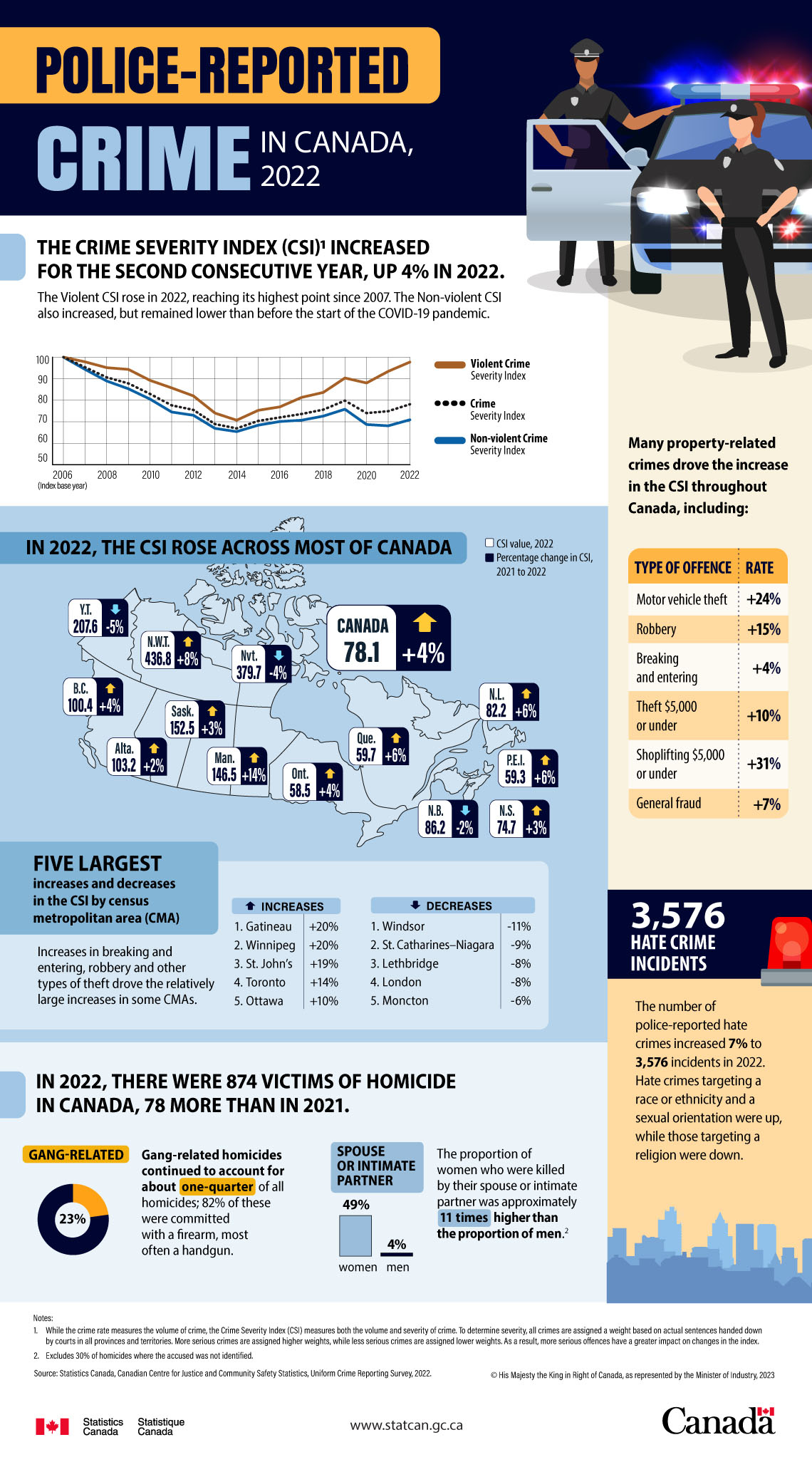Police-reported crime in Canada, 2022

Description: Police-reported crime in Canada, 2022
The Crime Severity Index (CSI)Note 1 increased for the second consecutive year, up 4% in 2022. The Violent CSI rose in 2022, reaching its highest point since 2007. The Non-violent CSI also increased, but remained lower than before the start of the COVID-19 pandemic.
| Year | Crime Severity IndexTable 1 Note 1 | Violent Crime Severity IndexTable 1 Note 1 | Non-violent Crime Severity IndexTable 1 Note 1 |
|---|---|---|---|
| 2006 *Index base year | 100 | 100 | 100 |
| 2007 | 95.3 | 97.8 | 94.3 |
| 2008 | 90.6 | 95.1 | 88.9 |
| 2009 | 87.8 | 94.3 | 85.3 |
| 2010 | 82.9 | 89.2 | 80.5 |
| 2011 | 77.6 | 85.7 | 74.5 |
| 2012 | 75.5 | 82 | 73 |
| 2013 | 68.9 | 74 | 66.9 |
| 2014 | 66.9 | 70.7 | 65.4 |
| 2015 | 70.4 | 75.3 | 68.4 |
| 2016 | 72 | 76.9 | 70.1 |
| 2017 | 73.6 | 81.3 | 70.7 |
| 2018 | 75.6 | 83.6 | 72.6 |
| 2019 | 79.8 | 90.3 | 75.8 |
| 2020 | 74 | 88 | 68.7 |
| 2021 | 74.9 | 93.4 | 68.1 |
| 2022 | 78.1 | 97.7 | 70.9 |
In 2022, the CSI rose across most of Canada
| Province or territory | CSI value, 2022 | Percentage change in CSI, 2021 to 2022 |
|---|---|---|
| Newfoundland and Labrador | 82.2 | +6% |
| Prince Edward Island | 59.3 | +6% |
| Nova Scotia | 74.7 | +3% |
| New Brunswick | 86.2 | -2% |
| Quebec | 59.7 | +6% |
| Ontario | 58.5 | +4% |
| Manitoba | 146.5 | +14% |
| Saskatchewan | 152.5 | +3% |
| Alberta | 103.2 | +2% |
| British Columbia | 100.4 | +4% |
| Yukon | 207.6 | -5% |
| Northwest Territories | 436.8 | +8% |
| Nunavut | 379.7 | -4% |
| Canada | 78.1 | +4% |
Many property-related crimes drove the increase in the CSI throughout Canada, including:
| Type of offence | Rate |
|---|---|
| Motor vehicle theft | Rate +24% |
| Robbery | Rate +15% |
| Breaking and entering | Rate +4% |
| Theft $5,000 or under | Rate +10% |
| Shoplifting $5,000 or under | Rate +31% |
| General fraud | Rate +7% |
3,576 hate crime incidents
- The number of police-reported hate crimes increased 7% to 3,576 incidents in 2022. Hate crimes targeting a race or ethnicity and a sexual orientation were up, while those targeting a religion were down.
In 2022, there were 874 victims of homicide in Canada, 78 more than in 2021.
Gang-related 23%: Gang-related homicides continued to account for about one-quarter of all homicides; 82% of these were committed with a firearm, most often a handgun.
Spouse or intimate partner, women (49%) versus men (4%): The proportion of women who were killed by their spouse or intimate partner was approximately 11 times higher than the proportion of men.Note 2
Five largest increases and decreases in the CSI by census metropolitan area (CMA)
| Census metropolitan area | Percentage change in CSI, 2021 to 2022 |
|---|---|
| Top 5 increases by CMA | |
| Gatineau | +20% |
| Winnipeg | +20% |
| St. John’s | +19% |
| Toronto | +14% |
| Ottawa | +10% |
| Top 5 decreases by CMA | |
| Windsor | -11% |
| St. Catharines-Niagara | -9% |
| Lethbridge | -8% |
| London | -8% |
| Moncton | -6% |
Increases in breaking and entering, robbery and other types of theft drove the relatively large increases in some CMAs.
Source: Statistics Canada, Canadian Centre for Justice and Community Safety Statistics, Uniform Crime Reporting Survey, 2022.
- Date modified: